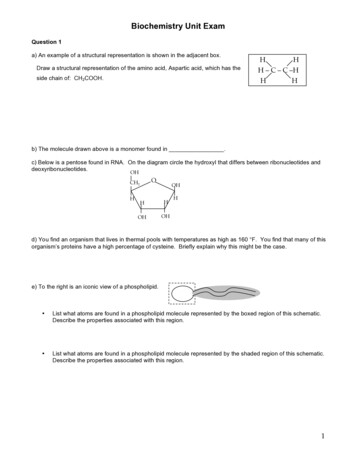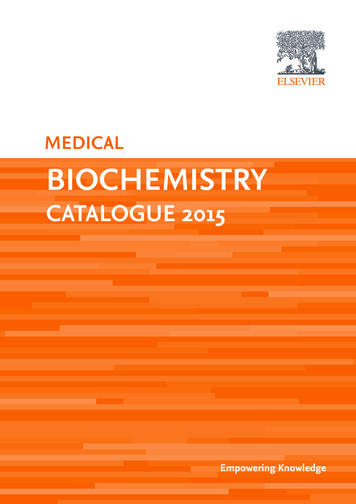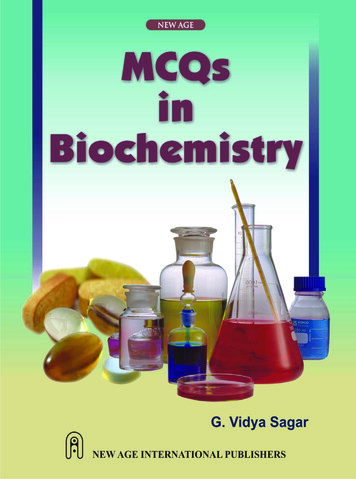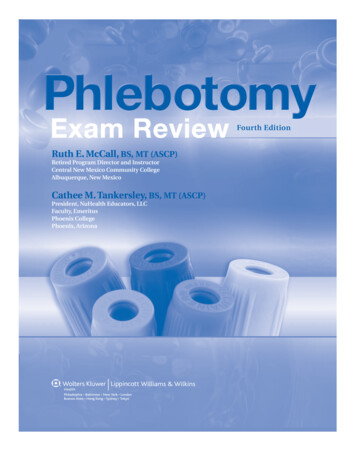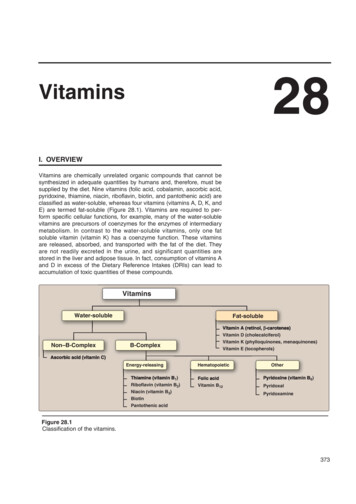
Transcription
28VitaminsI. OVERVIEWVitamins are chemically unrelated organic compounds that cannot besynthesized in adequate quantities by humans and, therefore, must besupplied by the diet. Nine vitamins (folic acid, cobalamin, ascorbic acid,pyridoxine, thiamine, niacin, riboflavin, biotin, and pantothenic acid) areclassified as water-soluble, whereas four vitamins (vitamins A, D, K, andE) are termed fat-soluble (Figure 28.1). Vitamins are required to perform specific cellular functions, for example, many of the water-solublevitamins are precursors of coenzymes for the enzymes of intermediarymetabolism. In contrast to the water-soluble vitamins, only one fatsoluble vitamin (vitamin K) has a coenzyme function. These vitaminsare released, absorbed, and transported with the fat of the diet. Theyare not readily excreted in the urine, and significant quantities arestored in the liver and adipose tissue. In fact, consumption of vitamins Aand D in excess of the Dietary Reference Intakes (DRIs) can lead toaccumulation of toxic quantities of these compounds.VitaminsWater-solubleFat-solubleVitamin D (cholecalciferol)Non–B-ComplexVitamin K (phylloquinones, menaquinones)Vitamin E cOther1)Riboflavin (vitamin B2)Niacin (vitamin B3)Biotin6)Vitamin B12PyridoxalPyridoxaminePantothenic acidFigure 28.1Classification of the vitamins.373
37428. VitaminsII. FOLIC ACIDNUTRITIONALANEMIASFolic acid (or folate), which plays a key role in one-carbon metabolism,is essential for the biosynthesis of several compounds. Folic acid deficiency is probably the most common vitamin deficiency in the UnitedStates, particularly among pregnant women and alcoholics.MICROCYTIC (MCV 80)A. Function of folic acidDeficiency in ironDeficiency in copperTetrahydrofolate (reduced folate) receives one-carbon fragmentsfrom donors such as serine, glycine, and histidine and transfersthem to intermediates in the synthesis of amino acids, purines, andthymidine monophosphate (TMP)—a pyrimidine found in DNA.Deficiency in pyridoxineNORMOCYTIC (MCV 80–100)B. Nutritional anemiasProtein-energyPt imalnutritionl t itiAnemia is a condition in which the blood has a lower than normalconcentration of hemoglobin, which results in a reduced ability totransport oxygen. Nutritional anemias—those caused by inadequateintake of one or more essential nutrients—can be classified according to the size of the red blood cells or mean corpuscular volumeobserved in the individual (Figure 28.2). Microcytic anemia, causedby lack of iron, is the most common form of nutritional anemia. Thesecond major category of nutritional anemia, macrocytic, resultsfrom a deficiency in folic acid or vitamin B12. [Note: These macrocytic anemias are commonly called megaloblastic because a deficiency of folic acid or vitamin B12 causes accumulation of large,immature red cell precursors, known as megaloblasts, in the bonemarrow and the blood.]MACROCYTIC (MCV 100)Deficiency in vitamin B12Deficiency in folateFigure 28.2Classification of nutritional anemiasby cell size. The normal meancorpuscular volume (MCV) forpeople older than age 18 is between80 and 100 μm3. [Note: Microcyticanemia is also seen with leadpoisoning.]1. Folate and anemia: Inadequate serum levels of folate can becaused by increased demand (for example, pregnancy and lactation), poor absorption caused by pathology of the small intestine,alcoholism, or treatment with drugs that are dihydrofolate reductaseinhibitors, for example, methotrexate (Figure 28.3). A folate-free dietMicroorganismsHumans and microorganismsGlutamateH2NC OO HPteridine p-Aminobenzoic acidprecursor(PABA)2 NADPH 2 HDihydropteroatesynthetase Amino acidsynthesisDihydrofolatereductaseFolic acid-2 NADP-Tetrahydrofolic teThymidinemonophosphatesynthesisOSulfonamides competitively inhibit the synthesis of folicacid in microorganisms and, thereby, decrease the synthesisof nucleotides needed for the replication of DNA.Dihydrofolate reductase is competitively inhibited bymethotrexate, a folic acid analogue used to treatpsoriasis, rheumatoid arthritis and neoplastic diseases.Figure 28.3Inhibition of tetrahydrofolate synthesis by sulfonamides and methotrexate.
III. Cobalamin (Vitamin B12)can cause a deficiency within a few weeks. A primary result of folicacid deficiency is megaloblastic anemia (Figure 28.4), caused bydiminished synthesis of purines and TMP, which leads to aninability of cells (including red cell precursors) to make DNA and,therefore, they cannot divide. [Note: It is important to evaluate thecause of the megaloblastic anemia prior to instituting therapy,because vitamin B12 deficiency indirectly causes symptoms of thisdisorder (see p. 377).]2. Folate and neural tube defects in the fetus: Spina bifida andanencephaly, the most common neural tube defects, affectapproximately 4,000 pregnancies in the United State annually.Folic acid supplementation before conception and during the firsttrimester has been shown to significantly reduce the defects.Therefore, all women of childbearing age are advised to consume0.4 mg/day of folic acid to reduce the risk of having a pregnancyaffected by neural tube defects. Adequate folate nutrition mustoccur at the time of conception because critical folate-dependentdevelopment occurs in the first weeks of fetal life — at a time whenmany women are not yet aware of their pregnancy. The U.S. Foodand Drug Administration has authorized the addition of folic acidto enriched grain products, resulting in a dietary supplementationof about 0.1 mg/day. It is estimated that this supplementation willallow approximately 50% of all reproductive-aged women toreceive 0.4 mg of folate from all sources. However, there is anassociation of high-dose supplementation with folic acid ( 0.8mg/day) and an increased risk of cancer. Thus, supplementationis not recommended for most middle-aged or older adults.375A Normal marrowB MegaloblasticmarrowFigure 28.4Bone marrow histology in normaland folate-deficient individuals.AN5-MethyltetrahydrofolateVitamin B12(Methylcobalamin)MethioninesynthaseIII. COBALAMIN (VITAMIN B12)Vitamin B12 is required in humans for two essential enzymatic reactions: the remethylation of homocysteine to methionine and the isomerization of methylmalonyl coenzyme A (CoA) that is produced during thedegradation of some amino acids (isoleucine, valine, threonine, andmethionine), and fatty acids with odd numbers of carbon atoms (Figure28.5). When the vitamin is deficient, unusual fatty acids accumulateand become incorporated into cell membranes, including those of thenervous system. This may account for some of the neurologic manifestations of vitamin B12 Fatty acids(odd number of carbons)COO–H3C C HC CoAOMethylmalonyl CoAA. Structure of cobalamin and its coenzyme formsCobalamin contains a corrin ring system that differs from the porphyrins in that two of the pyrrole rings are linked directly rather thanthrough a methene bridge. Cobalt is held in the center of the corrinring by four coordination bonds from the nitrogens of the pyrrolegroups. The remaining coordination bonds of the cobalt are with thenitrogen of 5,6-dimethylbenzimidazole and with cyanide in commercial preparations of the vitamin in the form of cyanocobalamin (Figure28.6). The coenzyme forms of cobalamin are 5'-deoxyadenosylcobalamin, in which cyanide is replaced with 5'-deoxyadenosine(forming an unusual carbon–cobalt bond), and methylcobalamin, inwhich cyanide is replaced by a methyl group (see Figure 28.6).Methylmalonyl CoAmutaseVitamin B12(Deoxyadenosylcobalamin)COO–H2C CH2C CoAOSuccinyl CoAFigure 28.5Reactions requiring coenzymeforms of vitamin B12.
37628. H2NONH2NONNH3COHCNH2NNHNH2NCH3 CoCH3H2 NCH3CH3NOCH3CH3CH3NH2CH3OOHNHCorrin ringOO P O–CH3ONCHH3NCHH3ODimethylbenzimidazoleOOHFigure 28.6Structure of vitamin B12 (cyanocobalamin) and its coenzyme forms (methylcobalamin and 5'-deoxyadenosylcobalamin).B. Distribution of cobalaminVitamin B12 is synthesized only by microorganisms; it is not presentin plants. Animals obtain the vitamin preformed from their naturalbacterial flora or by eating foods derived from other animals.Cobalamin is present in appreciable amounts in liver, whole milk,eggs, oysters, fresh shrimp, pork, and chicken.B12Diet12BParietalcellsC. Folate trap hypothesisIFIntrinsic factor(glycoprotein)STOMACHIFB12To ileumThe effects of cobalamin deficiency are most pronounced in rapidlydividing cells, such as the erythropoietic tissue of bone marrow andthe mucosal cells of the intestine. Such tissues need both the N5,N10methylene and N10-formyl forms of tetrahydrofolate for the synthesisof nucleotides required for DNA replication (see pp. 293 and 303).However, in vitamin B12 deficiency, the utilization of the N5-methylform of tetrahydrofolate in the B12-dependent methylation of homocysteine to methionine is impaired. Because the methylated form cannot be converted directly to other forms of tetrahydrofolate, folate istrapped in the N5-methyl form, which accumulates. The levels of theother forms decrease. Thus, cobalamin deficiency is hypothesized tolead to a deficiency of the tetrahydrofolate forms needed in purine andTMP synthesis, resulting in the symptoms of megaloblastic anemia.D. Clinical indications for vitamin B12B12B12-bindingproteinsBLOODMUCOSAL CELLIN ILEUMB12IFB12LUMENOF GUTFigure 28.7Absorption of vitamin B12. IF intrinsic factor.In contrast to other water-soluble vitamins, significant amounts(4–5 mg) of vitamin B12 are stored in the body. As a result, it maytake several years for the clinical symptoms of B12 deficiency todevelop in individuals who have had a partial or total gastrectomy(who, therefore, become intrinsic factor-deficient, see p. 377) andcan no longer absorb the vitamin.1. Pernicious anemia: Vitamin B12 deficiency is rarely a result of anabsence of the vitamin in the diet. It is much more common to find
IV. Ascorbic Acid (Vitamin C)deficiencies in patients who fail to absorb the vitamin from theintestine. Malabsorption of cobalamin in the elderly is most oftendue to reduced secretion of gastric acid and less efficient absorption of vitamin B12 from foods. A severe malabsorption of vitaminB12 leads to pernicious anemia. This disease is most commonly aresult of an autoimmune destruction of the gastric parietal cells thatare responsible for the synthesis of a glycoprotein called intrinsicfactor. Normally, vitamin B12 obtained from the diet binds to intrinsicfactor in the intestine (Figure 28.7). The cobalamin–intrinsic factorcomplex travels through the gut and eventually binds to specificreceptors on the surface of mucosal cells of the ileum. The boundcobalamin is transported into the mucosal cell and, subsequently,into the general circulation, where it is carried by B12-binding proteins. Lack of intrinsic factor prevents the absorption of vitamin B12,resulting in pernicious anemia. Patients with cobalamin deficiencyare usually anemic, but later in the development of the diseasethey show neuropsychiatric symptoms. However, central nervoussystem (CNS) symptoms may occur in the absence of anemia. TheCNS effects are irreversible and occur by mechanisms that appearto be different from those described for megaloblastic anemia. Thedisease is treated by giving high-dose B12 orally, or intramuscular(IM) injection of cyanocobalamin. Therapy must be continuedthroughout the lives of patients with pernicious anemia. Deficiencyof vitamin B12 can be measured by the level of methylmalonic acidin blood, which is elevated in individuals with low intake ordecreased absorption of the vitamin.Folic acid can partially reverse the hematologicabnormalities of B12 deficiency and, therefore,can mask a cobalamin deficiency. Thus, therapyof megaloblastic anemia is often initiated withfolic acid and vitamin B12 until the cause of theanemia can be determined.377OHC C C C C CH2OHO OH OH H OHFigure 28.8Structure of ascorbic acid.Figure 28.9Hemorrhage and swollen gums ofa patient with scurvy.OCHOOHHO–CH2– PyridoxalThe active form of vitamin C is ascorbic acid (Figure 28.8). The mainfunction of ascorbate is as a reducing agent in several different reactions. Vitamin C has a well-documented role as a coenzyme in hydroxylation reactions, for example, hydroxylation of prolyl and lysyl residues ofcollagen (see p. 47). Vitamin C is, therefore, required for the maintenance of normal connective tissue, as well as for wound healing. VitaminC also facilitates the absorption of dietary iron from the intestine.A. Deficiency of ascorbic acidA deficiency of ascorbic acid results in scurvy, a disease characterized by sore and spongy gums, loose teeth, fragile blood vessels,swollen joints, and anemia (Figure 28.9). Many of the deficiencysymptoms can be explained by a deficiency in the hydroxylation ofcollagen, resulting in defective connective tissue.PyridoxalphosphateCH2NH2OH.N.OHN CH3HHHO–CH2–HO3PO–CH2–N CH3IV. ASCORBIC ACID (VITAMIN neCONHNH2IsoniazidNFigure 28.10Structures of vitamin B6 and andthe antituberculosis drug isoniazid.
37828. VitaminsB. Prevention of chronic diseaseAHNH2 SNNCH3OHCH3NThiamineVitamin C is one of a group of nutrients that includes vitamin E (seep. 391) and β-carotene (see p. 382), which are known as anti oxidants. Consumption of diets rich in these compounds is associated with a decreased incidence of some chronic diseases, such ascoronary heart disease and certain cancers. However, clinical trialsinvolving supplementation with the isolated antioxidants have failedto determine any convincing beneficial effects.ATPV. PYRIDOXINE (VITAMIN B6)AMPHReactivecarbonNH2 SNCH3NNCH3OO P OO–O P OO––Vitamin B6 is a collective term for pyridoxine, pyridoxal, and pyridoxamine, all derivatives of pyridi
B. Distribution of cobalamin Vitamin B 12 is synthesized only by microorganisms; it is not present in plants. Animals obtain the vitamin preformed from their natural bacterial flora or by eating foods derived from other animals.
